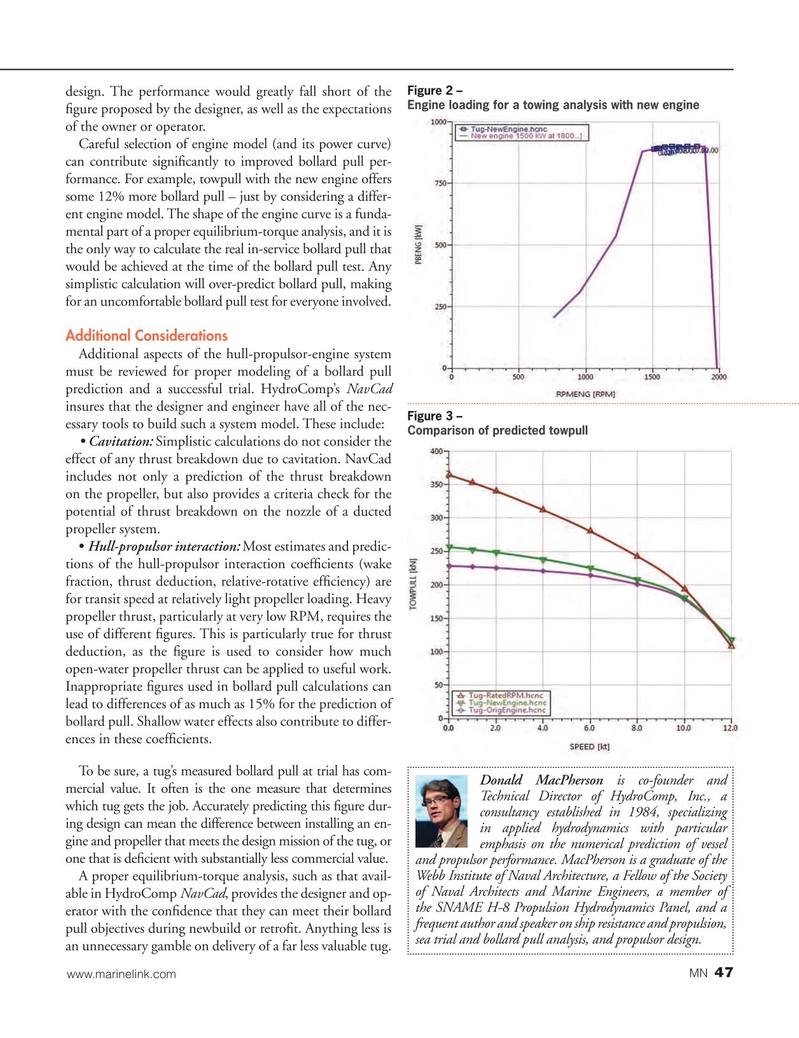
Page 47: of Marine News Magazine (December 2015)
Innovative Products & Boats of 2015
Read this page in Pdf, Flash or Html5 edition of December 2015 Marine News Magazine
Figure 2 – design. The performance would greatly fall short of the
Engine loading for a towing analysis with new engine ? gure proposed by the designer, as well as the expectations of the owner or operator.
Careful selection of engine model (and its power curve) can contribute signi? cantly to improved bollard pull per- formance. For example, towpull with the new engine offers some 12% more bollard pull – just by considering a differ- ent engine model. The shape of the engine curve is a funda- mental part of a proper equilibrium-torque analysis, and it is the only way to calculate the real in-service bollard pull that would be achieved at the time of the bollard pull test. Any simplistic calculation will over-predict bollard pull, making for an uncomfortable bollard pull test for everyone involved.
Additional Considerations
Additional aspects of the hull-propulsor-engine system must be reviewed for proper modeling of a bollard pull prediction and a successful trial. HydroComp’s NavCad insures that the designer and engineer have all of the nec-
Figure 3 – essary tools to build such a system model. These include:
Comparison of predicted towpull • Cavitation: Simplistic calculations do not consider the effect of any thrust breakdown due to cavitation. NavCad includes not only a prediction of the thrust breakdown on the propeller, but also provides a criteria check for the potential of thrust breakdown on the nozzle of a ducted propeller system. • Hull-propulsor interaction: Most estimates and predic- tions of the hull-propulsor interaction coef? cients (wake fraction, thrust deduction, relative-rotative ef? ciency) are for transit speed at relatively light propeller loading. Heavy propeller thrust, particularly at very low RPM, requires the use of different ? gures. This is particularly true for thrust deduction, as the ? gure is used to consider how much open-water propeller thrust can be applied to useful work.
Inappropriate ? gures used in bollard pull calculations can lead to differences of as much as 15% for the prediction of bollard pull. Shallow water effects also contribute to differ- ences in these coef? cients.
To be sure, a tug’s measured bollard pull at trial has com-
Donald MacPherson is co-founder and mercial value. It often is the one measure that determines
Technical Director of HydroComp, Inc., a which tug gets the job. Accurately predicting this ? gure dur- consultancy established in 1984, specializing ing design can mean the difference between installing an en- in applied hydrodynamics with particular gine and propeller that meets the design mission of the tug, or emphasis on the numerical prediction of vessel one that is de? cient with substantially less commercial value. and propulsor performance. MacPherson is a graduate of the
A proper equilibrium-torque analysis, such as that avail- Webb Institute of Naval Architecture, a Fellow of the Society of Naval Architects and Marine Engineers, a member of able in HydroComp NavCad, provides the designer and op- the SNAME H-8 Propulsion Hydrodynamics Panel, and a erator with the con? dence that they can meet their bollard frequent author and speaker on ship resistance and propulsion, pull objectives during newbuild or retro? t. Anything less is sea trial and bollard pull analysis, and propulsor design.
an unnecessary gamble on delivery of a far less valuable tug.
47 www.marinelink.com MN
MN Dec15 Layout 32-49.indd 47 11/24/2015 9:38:13 AM

 46
46

 48
48
